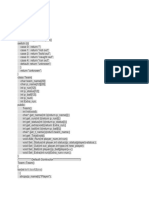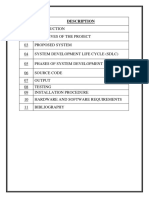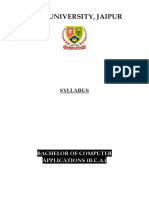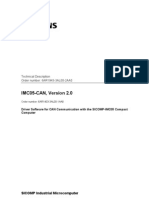Network and Distributed OS
Uploaded by
Sarfaraz EdrishNetwork and Distributed OS
Uploaded by
Sarfaraz EdrishExperiment No:
Aim: Case study on Network Operating System and Distributed Operating System.
Theory:
Network Operating System
Network operating system refers to software that implements an operating system of some kind that is
oriented to computer networking. For example, one that runs on a server and enables the server to manage
data, users, groups, security, applications, and other networking functions. The network operating system
is designed to allow shared file and printer access among multiple computers in a network, typically a
local area network (LAN), a private network or to other networks.
Network operating systems can be based on a client/server architecture in which a server enables multiple
clients to share resources. Client/server network operating systems allow the network to centralize
functions and applications in one or more dedicated file servers. The server is the center of the system,
allowing access to resources and instituting security. The network operating system provides the
mechanism to integrate all the components on a network to allow multiple users to simultaneously share
the same resources regardless of physical location.
Network operating systems can be based on a client/server architecture in which a server enables multiple
clients to share resources. Client/server network operating systems allow the network to centralize
functions and applications in one or more dedicated file servers. The server is the center of the system,
allowing access to resources and instituting security. The network operating system provides the
mechanism to integrate all the components on a network to allow multiple users to simultaneously share
the same resources regardless of physical location.
Characteristics:
Extension of centralized operating systems.
Offer local services to remote clients.
Each processor has own operating system.
User owns a machine, but can access others (e.g. rlogin, telnet).
No global naming of resources.
System has little fault tolerance.
Advantages:
Centralized servers are highly stable.
Security is server managed.
Upgrades to new technologies and hardwares can be easily integrated into the system.
Remote access to servers is possible from different locations and types of systems.
Disadvantages:
High cost of buying and running a server.
Dependency on a central location for most operations.
Regular maintenance and updates are required.
Distributed Operating System
A distributed operating system is software over a collection of independent, networked, communicating,
and physically separate computational nodes. Each individual node holds a specific software subset of the
global aggregate operating system. Each subset is a composite of two distinct service provisioners. The
first is a ubiquitous minimal kernel, or microkernel, that directly controls that nodes hardware. Second is
a higher-level collection of system management components that coordinate the node's individual and
collaborative activities. These components abstract microkernel functions and support user applications.
The microkernel and the management components collection work together. They support the systems
goal of integrating multiple resources and processing functionality into an efficient and stable system.
This seamless integration of individual nodes into a global system is referred to as transparency, or single
system image; describing the illusion provided to users of the global systems appearance as a single
computational entity.
A distributed OS provides the essential services and functionality required of an OS, adding attributes and
particular configurations to allow it to support additional requirements such as increased scale and
availability. To a user, a distributed OS works in a manner similar to a single-node, monolithic operating
system. That is, although it consists of multiple nodes, it appears to users and applications as a singlenode.
Characteristics:
Allows multicomputer network resources to be integrated as a single system image.
Hide and manage hardware and software resources.
Provides transparency support.
Provide heterogeneity support.
Control network in most effective way.
Consists of low level commands + local operating systems + distributed features.
Advantages:
Performance: very often a collection of processors can provide higher performance and better
price/performance ratio than a centralized computer.
Distribution: many applications involve, by their nature, spatially separated machines (banking,
commercial, automotive system).
Reliability: if some of the machines crash, the system can survive.
Incremental growth: as requirements on processing power grow, new machines can be added
incrementally.
Sharing of data/resources: shared data is essential to many applications (banking, computer
supported cooperative work, reservation systems); other resources can be also shared (e.g.
expensive printers).
Communication: facilitates human-to-human communication
Disadvantages:
Security problems: Sharing generates the problem of data security.
Networking problems: Several problems are created by the network infrastructure, which have to
be dealt with: loss of messages, overloading.
System
NOS
DOS
Description
Loosely-coupled operating system for
heterogeneous multicomputers (LAN and
WAN)
Tightly-coupled operating system for multiprocessors and homogeneous
multicomputers
Main Goal
Offer local services to remote
clients
Hide and manage hardware
resources
Middleware
Additional layer atop of NOS implementing
general-purpose services
Provide distribution
transparency
Different criteria and the individual differences:
1. User Awareness:
NOS: Users are aware of multiplicity of machines.
DOS: Users are not aware of multiplicity of machines.
2. Resource Access:
NOS: Access to resources of various machines is done explicitly by remote logging into the
appropriate remote machine or transferring data from remote machines to local machines, via the
File Transfer Protocol (FTP) mechanism.
DOS: Access to remote resources similar to access to local resources.
3. Computation and Data Migration:
NOS: Transfer the data, to and from the remote server and only the server performs the all or
most of the computation.
DOS: Transfer the computation, rather than the data, across the system.
4. Process Migration:
NOS: Execute an entire process, or parts of it, at the remote server.
DOS: Execute an entire process, or parts of it, at different sites.
5. Architecture Model:
NOS: Employs a client-server model.
DOS: Employs a master-slave model.
Comparison of the characteristics of various types of Operating Systems:
Distributed OS
Multicomputers
Network
OS
Middleware-based
OS
Very High
High
Low
High
Same OS on all nodes
Yes
Yes
No
No
Number of copies of OS
Basis for
communication
Shared
memory
Messages
Files
Model specific
Resource management
Global, central
Global,
distributed
Per node
Per node
Scalability
No
Moderately
Yes
Varies
Openness
Closed
Closed
Open
Open
Item
Multiprocesso
r
Degree of transparency
Conclusion: Thus we have studied Network Operating System and Distributed Operating System.
You might also like
- Lec 1 - Number Systems and Digital LogicNo ratings yetLec 1 - Number Systems and Digital Logic38 pages
- Cricket Score Maintenance C++ Source CodeNo ratings yetCricket Score Maintenance C++ Source Code6 pages
- Chapter 1 - Introduction To Data Structure PDFNo ratings yetChapter 1 - Introduction To Data Structure PDF35 pages
- Deep Learning For Intelligent Wireless Networks: A Comprehensive SurveyNo ratings yetDeep Learning For Intelligent Wireless Networks: A Comprehensive Survey25 pages
- Atm Machine Management System Final-3-33 (1) - 2-31100% (1)Atm Machine Management System Final-3-33 (1) - 2-3130 pages
- Operating Systems: Chapter 5: Input/OutputNo ratings yetOperating Systems: Chapter 5: Input/Output26 pages
- Protection in General-Purpose Operating SystemsNo ratings yetProtection in General-Purpose Operating Systems13 pages
- C. Application Do Activity Sheet 3.1 Pg. 25100% (1)C. Application Do Activity Sheet 3.1 Pg. 2519 pages
- Project Report (Group - 2) 17bcs4090,91 & 86No ratings yetProject Report (Group - 2) 17bcs4090,91 & 8621 pages
- Conditional Statements in C ProgrammingNo ratings yetConditional Statements in C Programming11 pages
- Lesson Plan: Data Types and Data RepresentationNo ratings yetLesson Plan: Data Types and Data Representation43 pages
- Computer Organization and Operating Systems PDF0% (2)Computer Organization and Operating Systems PDF90 pages
- PSA3 Technical - PHP Arrays and User Defined FunctionsNo ratings yetPSA3 Technical - PHP Arrays and User Defined Functions13 pages
- Operating Systems Lab: Implement The Following Using C/C++/JAVANo ratings yetOperating Systems Lab: Implement The Following Using C/C++/JAVA22 pages
- Data Structure Using C: Proposal On Phone Directory Application Using Doubly-Linked ListNo ratings yetData Structure Using C: Proposal On Phone Directory Application Using Doubly-Linked List5 pages
- Teacher Subject Allocation Management System DocumentationNo ratings yetTeacher Subject Allocation Management System Documentation44 pages
- Chapter 1 - Intro To Programming Language 20182019No ratings yetChapter 1 - Intro To Programming Language 2018201954 pages
- Department of Computer Science and Engineering 18Cs43: Operating Systems Lecture Notes (QUESTION & ANSWER)100% (1)Department of Computer Science and Engineering 18Cs43: Operating Systems Lecture Notes (QUESTION & ANSWER)8 pages
- Digital Electronics & Computer OrganisationNo ratings yetDigital Electronics & Computer Organisation17 pages
- Accenture Coding Set B Sol - 6748548 - 2024 - 09 - 25 - 21 - 03No ratings yetAccenture Coding Set B Sol - 6748548 - 2024 - 09 - 25 - 21 - 0320 pages
- Sqli Filter Evasion and Obfuscation: Johannes Dahse, Prague, Czech Republic, 29-30.11.2010No ratings yetSqli Filter Evasion and Obfuscation: Johannes Dahse, Prague, Czech Republic, 29-30.11.201067 pages
- Secure and Practical Outsourcing of LinearNo ratings yetSecure and Practical Outsourcing of Linear122 pages
- The Open Commerce Handbook - CHAPTER 1 - FINALNo ratings yetThe Open Commerce Handbook - CHAPTER 1 - FINAL18 pages
- Employee Payroll Management System_Java AssignmentNo ratings yetEmployee Payroll Management System_Java Assignment23 pages
- Debugging HR Trigger - PA40 Changes To Infotypes - Governance, Risk and Compliance - SCN WikiNo ratings yetDebugging HR Trigger - PA40 Changes To Infotypes - Governance, Risk and Compliance - SCN Wiki1 page
- Human Computer Interaction Using Eyes (HCIE)No ratings yetHuman Computer Interaction Using Eyes (HCIE)7 pages

























































































